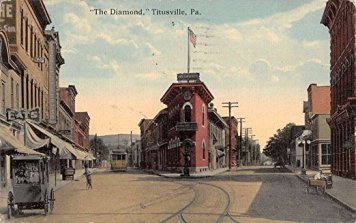
It was winter 1870 and men were keeping warm in the Oil Region with two hobbies: drinking and fighting. Both would play a part in the death of Rowland Kightlinger one December night in Hydetown, Pennsylvania.
Now, you may have heard that the Titusville of yesteryear was not quite the quiet Titusville of today. But did you know that only three miles to the north, Hydetown had its share of violent outbursts, hooligans, and bullies as well? It was said that young Rowland Kightlinger was one of those bullies.
The story of Rowland’s demise starts with his uncle, William Kightlinger. After a fight in the spring of 1870, William deserted his wife. Following their separation, one of William’s young employees, George Turner, “took part” with Mrs. Kightlinger, much to the dismay of the Kightlinger family. Kightlinger family members were so incensed by the new relationship between Mrs. Kightlinger and George Turner, age 23, that they reportedly assaulted and abused him whenever they crossed paths. On the night of Saturday, December 3rd, 1870, the family feud came to a head at Fulmer’s Bridge in Hydetown.

Throughout Saturday evening, both parties partook in drinking at different establishments in Titusville and subsequently headed home toward Hydetown. About halfway between Titusville and Hydetown, the two groups spotted one another. The Kightlingers were represented by John and Rowland Kightlinger, the brother and nephew of William, and Turner by George Turner and friends Frank Brown and Dr. Gage. Rowland came at George at once, beating him and tearing his clothes from his back. After he was finished, the Kightlingers drove off in their wagon and Turner was rescued by his uncle William Turner and brother, also named William Turner, in addition to Brown and Gage. But the fight had only just begun.
While the Turners were rescuing George, the Kightlingers had set up shop at Ridgway’s Tavern and were telling everyone about the beating and becoming more drunk. Eventually, they ended up at Fulmer’s Bridge and declared they would wait there for George to pass so that they could “wait for him and lick him.” A half hour later, Frank Brown and George Turner ambled down the road toward the bridge in Brown’s wagon, not knowing what they were about to encounter.
Rowland Kightlinger yelled at Frank Brown to stop the wagon. Brown got out and attempted to placate Rowland — a mistake. In response, Rowland punched Brown in the face, giving him a black eye. With Brown out of the way, Rowland rushed toward George Turner in the wagon and attempted to pull him out. Turner rebuffed Rowland with his gun and pushed him away, but Rowland would not stop. While John Kightlinger yelled at him to shoot George with his revolver, Rowland grabbed the muzzle of the gun, once again trying to pull Turner out of the wagon. As Turner pulled back, the gun fired and the ball passed through Rowland’s heart, killing him.

A Justice was immediately notified, but by the time he arrived on the scene, all parties had fled, leaving only Rowland’s body, his wagon, gloves and the gun laying beside the deceased’s head. He determined that the deceased was indeed 23-year-old Rowland Kightlinger, and that “the general impression appears to be that Hydetown has got rid of a notoriously bad character” (Titusville Herald 12/5/1870).
The Titusville Herald reported that Rowland Kightlinger was a known bully and that George Turner was well-liked in the community. Abraham Kightlinger, Rowland’s father, took great offense to this and demanded George Turner be arrested for murder and Frank Brown as accessory to murder. Soon after, Turner and Brown turned themselves in but claimed self-defense.

The trial continued into January 1871. The Commonwealth argued that Turner and Brown conspired to attack the Kightlingers and laid in wait for them that night at Fulmer’s Bridge. The defense argued that Turner had been repeatedly subject to the Kightlingers’ attacks and on that night Rowland caused Turner grievous bodily injury and would have done so again had Turner not intentionally fired and killed him. This defense went against Turner’s own statements that he did not intentionally kill Kightlinger, but the defense presumably thought the former a stronger strategy.
On January 7, 1871, after only ten minutes deliberation, a jury found George Turner not guilty of murdering Rowland Kightlinger. In his own trial, Frank Brown was also found not guilty after zero minutes deliberation as the jury announced their verdict straight from the jury box.
A month after the incident, George Turner and Frank Brown could walk free once again in Hydetown, and Rowland Kightlinger was dead and buried. Moral of the story? If your uncle up and leaves his wife, don’t beat up her new, young boyfriend – the historical precedent for family feud survival is not in your favor.

Jessica, very interesting story about the killing in Hydetown. I enjoyed it very much. This burgh was quite a rip roaring place then. Dad.
LikeLiked by 1 person
We enjoy your stories. Thanks for the posts, and keep up the historical spirit.
LikeLiked by 1 person